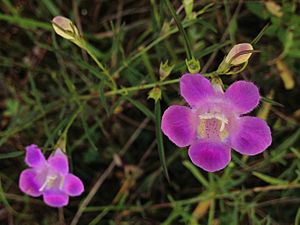Agalinis purpurea facts for kids
Quick facts for kids Agalinis purpurea |
|
|---|---|
 |
|
| Scientific classification | |
| Genus: |
Agalinis
|
| Species: |
purpurea
|
| Synonyms | |
Agalinis purpurea is a beautiful wild plant. It is also known as the purple false foxglove or purple gerardia. This plant grows every year from a seed. It is found naturally in the eastern parts of the United States and Canada. In late summer or early fall, it blooms with lovely purple flowers.
Contents
About the Purple False Foxglove
What Does It Look Like?
The purple false foxglove can grow quite tall. It can be anywhere from about 4 inches (10 centimeters) to almost 4 feet (120 centimeters) high. Its stem is thin and has many spreading branches.
The leaves are simple and grow opposite each other on the stem. They are usually 10 to 40 millimeters long. This is about 0.4 to 1.6 inches. The leaves are very narrow, only 0.5 to 2 millimeters wide.
The flowers grow in clusters along the branches. Each flower sits on a small stalk called a pedicel. These stalks are 1 to 8 millimeters long. The flowers are symmetrical, meaning they look the same on both sides. They have five petals that are joined together. These petals form a tube shape, about 20 to 38 millimeters long. Inside the flower, there are four stamens. After the flower fades, it produces a round, dry fruit. This fruit is a capsule, about 4 to 6 millimeters long. It splits open when it is ripe.
Where Does It Grow?
The purple false foxglove is found across the eastern United States. It grows in many states, from Alabama to Wisconsin. It is also found in the Canadian province of Ontario.
This plant likes certain types of places to grow. You can find it in wet areas like marshes and swamps. It also grows in low, wet spots between sand dunes. Sometimes, it appears in old fields that are no longer farmed.
However, this plant needs the right home to survive. If its habitat is changed or built over, it might disappear from that area. Other strong plants, especially those not native to the area, can also outcompete it.
How Does It Live?
The purple false foxglove is a special kind of plant. It is called a hemiparasite. This means it gets some of its food from other plants. It often connects to grasses and similar plants.
It uses special roots called haustoria. These roots connect to the roots of nearby host plants. This allows the foxglove to take some water and nutrients from them. But the purple false foxglove also has green leaves. This means it can make its own food through a process called photosynthesis. So, it doesn't rely completely on other plants.
How Scientists Classify It
Scientists group living things into categories. This helps them understand how different species are related. The purple false foxglove belongs to a group called Agalinis.
For a long time, scientists placed this plant in the Scrophulariaceae family. But with new research, they learned more about its relationships. Now, it is placed in the Orobanchaceae family. This change was made based on findings from a group called the Angiosperm Phylogeny Group. They study how flowering plants are related.


